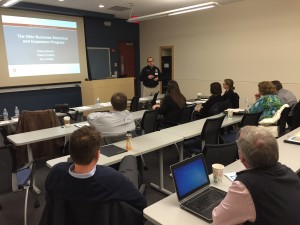Tourism is one of the fastest growing industry sectors in Ohio, growing two times faster than the overall employment in the state. In 2014, the industry produced $40 billion in business activity, accounting for $11.4 billion in personal income and almost 9% of jobs in Ohio (Tourism Economics).
 The Tourism Toolbox website was developed in 2009 by the Ohio Tourism Team, a public/private partnership involving OSU Extension, the Ohio Sea Grant Program and other partners including the Ohio Travel Association (OTA), for researchers, organizations and businesses interested in learning more about the industry.
The Tourism Toolbox website was developed in 2009 by the Ohio Tourism Team, a public/private partnership involving OSU Extension, the Ohio Sea Grant Program and other partners including the Ohio Travel Association (OTA), for researchers, organizations and businesses interested in learning more about the industry.
The site serves as a one-stop resource for starting a tourism-related business, creating a community plan, tracking industry trends, or accessing current resources, among other topics and reports. For example, a new report addressing the Ohio tourism industry’s core competencies, training needs and delivery preferences, Ohio Tourism Industry Needs Assessment 2014 Report, is now available on the site.
The site was recently updated and content was transferred to the Extension Community Development site, currently accessible at: comdev.osu.edu/programs/economic-development/ohio-tourism-toolbox.
(Submitted by Nancy Bowen, Associate Professor & Extension Field Specialist, Community Economics)

 Extension CD faculty
Extension CD faculty  Extension researchers recently shared the highlights of an advanced cluster analysis focused on manufacturing with community development officials in four EDD’s (economic development districts) within the eastern Ohio shale play. The cluster analysis is one of four analytical steps being conducted as part of an EDA (Economic Development Administration) funded project to inform the overall 25-county region about economic, social and environmental changes, potential implications and strategic directions for sustainable development.
Extension researchers recently shared the highlights of an advanced cluster analysis focused on manufacturing with community development officials in four EDD’s (economic development districts) within the eastern Ohio shale play. The cluster analysis is one of four analytical steps being conducted as part of an EDA (Economic Development Administration) funded project to inform the overall 25-county region about economic, social and environmental changes, potential implications and strategic directions for sustainable development. Economic impact analysis, or EIA, benefits communities, chambers, economic development organizations, associations and others who are seeking to understand and quantify economic changes. EIA programs are offered through Extension Community Development (CD) using IMPLAN, an input-output (I-O) modeling software. The model captures indirect and induced impacts that occur from an initial direct investment or series of investments using the most recent data available.
Economic impact analysis, or EIA, benefits communities, chambers, economic development organizations, associations and others who are seeking to understand and quantify economic changes. EIA programs are offered through Extension Community Development (CD) using IMPLAN, an input-output (I-O) modeling software. The model captures indirect and induced impacts that occur from an initial direct investment or series of investments using the most recent data available.